President's Message
The year 2018 was another good one for HCHS thanks to all our volunteers and partnerships. We call it teamwork. In the upcoming year, you will be pleased to see more of the Directors of each of the 5 magisterial districts of Henrico. We will be featuring the historical elements in your neighborhoods. It is easy in our day-to-day travels to pass by famliar sites without really considering their signficance. If you know of any little known tidbits of your area or have particular questions you would like answered, contact information is listed on the back of the newsletter.
If you were unable to join us for the field trip to Ferry Farm in partnership with the Association for the Preservation of Henrico Antiquities, you missed a real treat. The tour of the reconstructed boyhood home of George Washington was most informative. Additional plans for the site will eventually expand the presentation of the Washington family. It is an amazing story. If you visit, you may also want to cross the bridge into Fredericksburg and take the trolley tour from the Visitors Center on Caroline Street. It is interesting to see the Washington property from the other side of the Rappahannock River. Many homes of the era are on the tour and even a historic cobblestone roadway leading to the waterfront. Fredericksburg has done a wonderful job of creating a tourist destination, presenting the old with the new. There is something there for everyone.
We hope you will join us for our December 2nd quarterly meeting and meet Henrico's 2018 Christmas Mother, Angela Harper. Afterwards we will take a tour of the new renovated headquarters of the Henrico Division of Recreation and Parks. The building was the former location of the Dumbarton Library, which was vacated after the opening of the new Libby Mill Library. Prior to the Dumbarton Library, the site was the location of the old Dumbarton Elementary School. As part of the planning to build the Dumbarton Library, the old part of the school was declared unsafe and was razed in 1973. The part closest to Penick Rd. was built in 1956 and served as the "cafetorium." It remained and was incorporated into the library as the Children's Room - another example of long forgotten Henrico history.
Best wishes for a blessed holiday season and a happy 2019!
Sarah Pace
President
>Back to Top<
December Quarterly Meeting

Our December Quarterly Meeting will be Sunday, December 2nd, starting at 2:30p.m. It will take place at Henrico County Recreation & Parks, located at 6800 Staple Mills Road in Henrico, VA (23228).
Our speaker will be Angela Harper, Henrico's Christmas Mother.
>Back to Top<
Flashback to September Quarterly Meeting
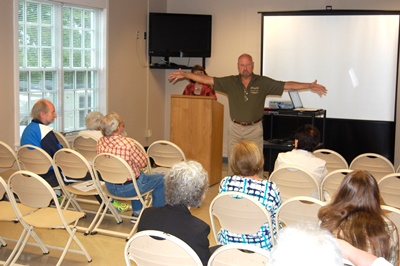
From beer to boats to battles. Tom Robinson delivers a multi-topic presentation covering the Yeungling Brewery, the Trigg Boatworks, and more at the September HCHS meeting at Confederate Hills.
>Back to Top<
Get Wrapped Up in Henrico County History
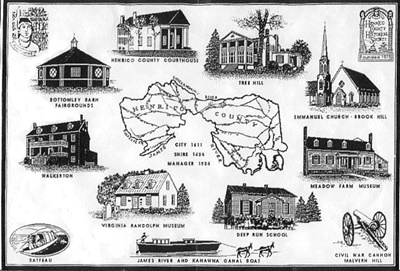
Why not treat yourself or someone on your gift list to our Henrico County Historical Society coverlet? It captures the history and spirit of the county with the depiction of historic county sites and events. It is rendered in Williamsburg blue on a natural 100% cotton, two-layer, jacquard woven in the USA. It is preshrunk, colorfast, and machine washable. It measures approximately 46x68 inches and is fringed on all four sides. It can be ordered on our shopping page.
>Back to Top<
Inventive Henricoans
On your desk do you have one of those things with five steel balls suspended from a frame where you swing one or two or three from one end they clack the same number into motion on the other end? Or maybe one of these liquid-filled canisters where colored blobs drip onto a path and roll down it until you have turned it over and start it again? Pointless, right?
In 1918, Henricoan George B. Bliley patented a toy equally pointless. Claiming to have invented "new and useful Toys", he offered a device in which marbles would roll down a spiral runway to a spring-driven elevator that would carry each one back to the start of the course. The process would continue until the spring wound down. Then, the child would rewrind the motor's key and start the process again.
We've never seen one of these, but we think Bliley was way ahead of his time but aiming for the wrong market. It's the perfect desktop toy. We're sorry he didn't supply a name for this device, and we would love to hear your suggestions for an appropriate title. We'll print your suggestions next time.
Send your ideas to:
jboehling@verizon.net
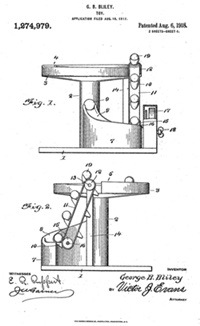
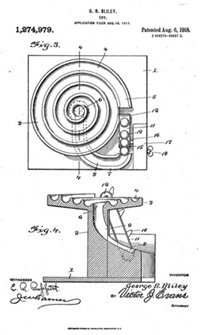
To all whom it may concern:
Be it known that I, GEORGE B. BLILEY, a citizen of the United States, residing at Richmond, in the county of Henrico and State of Virginia, have invented a new and useful Improvements in Toys, of which the following is a specification.
This invention is an improved toy adapted for keeping a series of small balls such as marbles in motion and embodying a motor driven elevator, a spirally arranged runway to which the marbles are successively supplied by the elevator, a drop column to which the marbles roll on the said run-way and a return run-way which conveys the marbles by gravity from the bottom of the drop column to the elevator so that the elevator is successively supplied with marbles to be carried thereby to the spiral run-way, the object of the invention being to provide an improved toy of this character which is simple in construction and which operates efficiently.
>Back to Top<
Innovator and Animal Lover George Watt Takes Us...Plowing Through Henrico's Past
While mazes always offer a wide selection of fruitless paths leading nowhere, wandering through the maze of connections in Henrico's past always provides an interesting trek, some surprise and often a degree of enlightenment. The June 2018 Newsletter article on Goddin's Tavern turned out to offer a path to an interesting and surprising story. You can decide whether or not it enlightens.
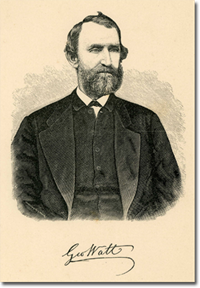
The article described the 1847 Henrico Agricultural and Horticultural Fair held at Goddin's Spring in which George Watt claimed a twenty-dollar prize in the plowing contest using the Cuff and Brace Plow of his own invention and manufacture. Watt was a Henrico resident who the 1840 census finds living in Richmond Ward 1, Henrico County. (Prior to 1870, when state law changed to allow independent cities Richmond was located in Henrico County). He had been born in Hanover County in 1815, and later apprenticed to John Haw in Hanover to learn mechanics. Released from his apprenticeship, he went south to Alabama where in 1842, he received his first of almost 20 patents - this one for his Cuff, Brace and Gauge Plow.
He returned to Virginia and in 1846, he was running Geo. Watt & Company at 1450 Franklin Street. He married Sara Haw Hooper, also known as and listed as Sally and Sallie in censuses, on 25 October 1852; and they had three children: George, Cornelia, and Betty.
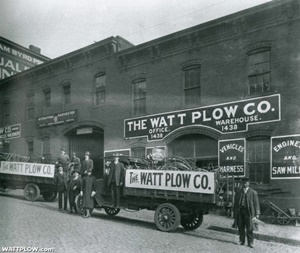
His reputation, it seems, was widespread, with the August 1875 Southern Planter and Farmer printing his likeness on its frontispiece and identifying him in an article as "the plow-maker of Richmond" and praising the Watt Plow as "not only the lightest running, but also the most easily regulated [plow]" that had been introduced everywhere throughout the South, and give entire satisfaction wherever used."
Watt Plow Company: This building, now gone, stood at what is now 1450 East Franklin Street.
Despite his myriad other inventions, as shown later, that first plow and multiple subsequent improvements seemed to be his proudest achievement. He ran an ad in the 28 September 1866 Richmond Times naming that plow, wiht apparently recently patented improvements "A Plow for the Times" claiming it required a fourth the power, provided twice the strength and durability and a ten-fold ability to avoid choking and clogging over any of its competitors. Adding a long list of farmers vouching for its efficacy, he ended the announcement by identifying himself as "George Watt, Plow-maker."
While that implement might have defined him in the business world, his concern for animals defined him in the world of public service where he was instrumental in establishing the Richmond Society for the Prevention of Cruelty to Animals. His concern first shows up in 15 February 1881 Staunton Spectator taken from the Southern Planter and Farmer. Complaining of the effects of careless horse shoeing, he says that destroying the hoof "by careless inhumanity, or the want of common sense to do the work correctly. . .should be a punishable and fineable offence by laws which should at once be enacted by every State in the Union.
Then on 16 January 1883, he asks the Daily Dispatch, "Where Are the Police?" because of the "inhuman treatment of teams [of horses] on our streets in their icy condition." Decrying the whipping and beating of the struggling animals, he concludes, "We have laws which positively forbid such cruelties to animals, and the police could if they would stop these inhuman scenes."
Shortly thereafter, the Dispatch of 7 February announces a meeting to be held at the Exchange Hotel for the formation of a Society for the Prevention of Cruelty to Animals, ending by announcing, "Our worthy fellow-citizen Mr. George Watt signs the call." And at that meeting, according to the Dispatch of 9 February, George Watt was made temporary president.
However, Watt was not without his detractors. An anonymous correspondent sent a letter to the Daily Dispatch of 5 April 1883 to comment on a fox hunt lately held at Watt's Hanover County farm by saying, "The fact that Mr. Watt is the distinguished promoter of the Society for the Prevention of Cruelty to animals . . . makes it the more surprising that he should be persecuting so amiable an animal as the red fox. The Society will probably deem it a matter of sufficient moment to appoint a committee of inquiry." Two days later, the Dispatch published a response from someone in Glen Allen who suggested the original correspondent was dealing in sarcasm.
In the interim, Watt himself had responded in the 6 April edition and defended himself through a listing of the harm done by foxes and concludes, "was it not humane in me to get up a hunt in which a large number of friends should engage so to enjoy the sport whilst ridding the country of the four-legged nuisances."
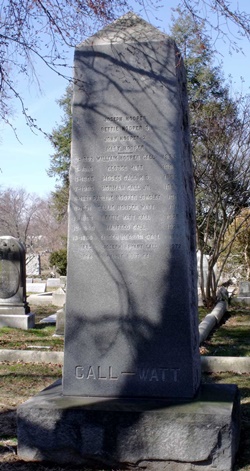
It seems, however, that Watt's good name and character were unassailable as indicated by his obituary in the Daily Dispatch of 27 December 1884, and just six days before his death, a fire department destroyed the 'moulding' department of the Watt & call business with 400 wagons stored inside. The obituary noted "He was a valuable citizen, and was ever ready to aid the poor and distressed. He was a leading member of the Tuckahoe Farmers' Club, and it was greatly though his instrumentality that the Richmond Society for the Prevention of Cruelty to Animals was organized. His life was a long and useful one, and his death is deeply regretted.". This echoed the praise lavished on him in the August 1875 Southern Planter and Farmer: "If men are to be judged by the amount of good they do in life, George Watt will rank very high among the honored sons of Virginia."
George Watt's gravesite: After his funeral at First Baptist Church, Watt was interred at Hollywood Cemetery.
So following Captain John Goddin through the maze of Henrico history, we crossed paths with George Watt. Who would ever want to find a way out of the maze?
Joey Boehling
Watt-Starke Patent Feud Plows Its Way to the Supreme Court
It seems that George Watt had a long-running feud with competitor P.H. Starke, the apparent object of his complaint in the announcement to the left from the Daily Dispatch of 1 January 1860. Over the previous years, Watt had obtained multiple patents on his plows and on subsequent improvements on them; and as his complaint indicates, he guarded them jealously.
In 1867, he had procured a patent for improvements on his previously patented Cuff-Brace plow illustrated in the patent grant at the bottom left. It was a "breast improvement" designed to prevent plows from choking with weeds and trash.
Watt filed suit against Starke over infringement of patent rights in 1870, but when the case was decided in 1872, the jury found for the defendant. Watt's appeal went all the way to the Supreme Court in 1879, and the 1890 decision in Watt v. Stark went in Starke's favor.
While a dispute over something like the design of an agricultural implement may not seem overly exciting, the Daily Dispatch of 13 January 1880 said, "Thus has ended a case which for ten years has excited as much interest as perhaps any case which has been adjudicated by the Federal Court of this district.
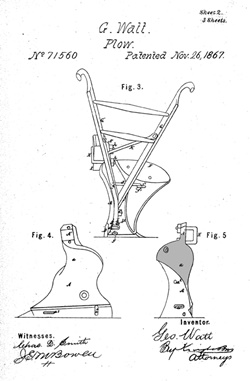
The patent in question: Watt's patent no. 71560 of 26 November 1867, claimed to improve the plows ability to avoid choking with weeds and trash. It was due to what he said was a "breast improvement.". In the illustration, we have shaded the area of the plow's breast in a light gray.
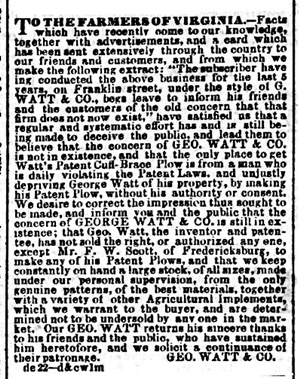
A sampler of George Watt' other patented inventions:
1 - Corn Planter, 1859; 2 - Whiffletree, 1866; 3 - Harrows, 1873
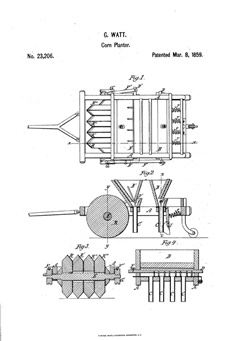
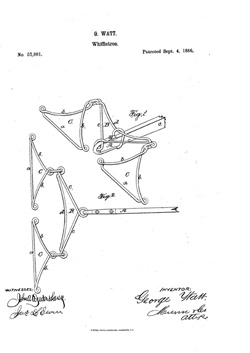
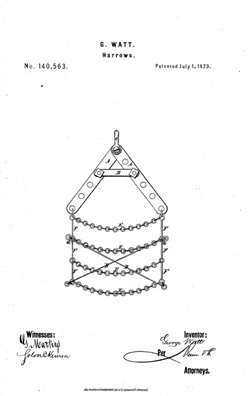
>Back to Top<
Now You Know
Taking Your Best Shot
Congratulations to Anne W. Jackson for identifying the object seen at the left was a device for measuring powder for reloading shotgun shells.
HCHS member Haywood Wigglesworth provided the item for the article, and he provided the following explanation of its use:
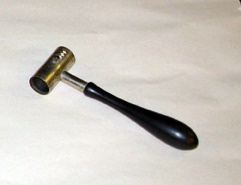
"These measures would have been sold primarily for the purpose of reloading shotgun shells in bulk. (A friend who does a lot of shooting with muzzle-loading guns says that an adjustable shot and power measure is still used on the firing line in matches.) They appear to have been sold separately but also as part of reloading kits from the 1880's to the 1940's. Empty shells, primers, gunpowder, wads and shot could be purchased from the same source as the reloading tools. The power measure would have been set first, pushing the cup inside the tube down until the pin was opposite the desired measure in drams for the gunpowder. The empty shells would already have had their primers replaced using other tools. The proper amount of gunpowder could then be poured in each shell to be reloaded. After each shell was charged with powder, a wad or wads were placed on top of the powder in the shells. Then the measure would have been reset for the desired charge of shot and then that charge of shot would have been poured into each shell. A wad would have been placed over the charge and the top of the shell would have been crimped to keep everything in place. For people of little means or who were far away from stores that sold ammunition, reloading would have been a necessity. That is probably why these simple tools were sold for so long.
And Making Shot
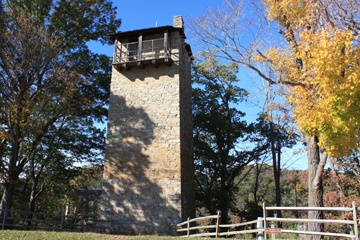
Of course the powder measurer would have been useless without shot to load into the shell later. Modern shot manufacturing is a precise process with extremely tight tolerances; but in much earlier times, ammunition manufacturers relied on decidely low-tech, but effective, shot towers.
The 200-year-old Jackson Ferry Shot Tower in Wythe County, Virginia (pictured right) is a fine example.
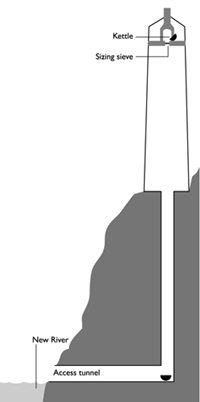
This 75-foot "factory" sits above a 75-foot shaft with a large kettle of water at the base. Lead from the nearby Austinville mines was melted in a kettle at the top of the tower, and the molten lead was then poured through a sieve whose openings determined the size of the shot. Surface tension on the metal caused it to form a sphere during its fall. It also partially cooled on the way down, and the kettle of water at the base finished the process.
Retrieving the shot from the bottom of the shaft could be problematic, but the location of the Jackson Ferry Shot Tower helped make the process a bit easier. The tower sits on an elevation overlooking the New River, so the tower builders dug a horizontal tunnel from the river bank below to provide access to the kettle. The maximum size of the shot was limited by the height of the tower, and this one could have produced the equivalent of about #6 shot.
>Back to Top<
What Do You Know?
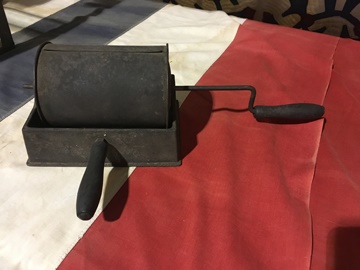
The barrel of the metal item pictured above has a sliding door and is approximately 8 inches wide. The crank turns the barrel in the carriage in which it rests.
Do you know what it is?
Email your answers to:
jboehling@verizon.net
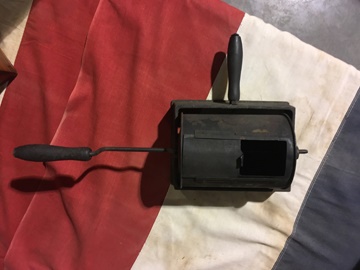
If you have an unusual object that you think we might be interested in for this quarterly feature, let us know. We'd love to hear from you.
>Back to Top<
News 2018: Fourth Quarter
First Quarter | Second Quarter | Third Quarter
Home | Henrico | Maps | Genealogy | Preservation | Membership | Shopping | HCHS
|











